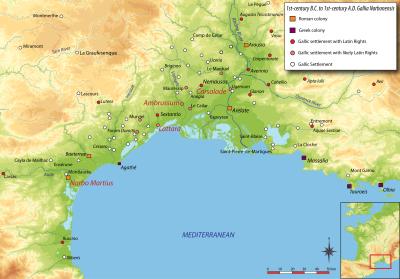
Cite this as: Luley, B. 2018 A Terra Sigillata Revolution? Terra sigillata consumption in first-century AD Roman Mediterranean Gaul, Internet Archaeology 50. https://doi.org/10.11141/ia.50.8
This article examines the varying uses of Gallic terra sigillata at several sites in eastern Languedoc for the first century AD (Figure 1), investigating how the same terra sigillata vessel forms may have been used in different ways depending upon social context. By the end of the first century BC, significant social, political, cultural, and economic changes were sweeping the province of Gallia Narbonensis. One of the most archaeologically visible of these changes was the appearance of red gloss terra sigillata dining vessels throughout the province. Originally made in the Italian peninsula, by the first century AD these terra sigillata vessels were largely produced locally in southern Gaul, most notably at the workshops of La Graufesenque (Bémont and Jacob 1986; Bémont et al. 1987; Schaad 2007), and had become the most common dining vessel at settlements throughout Gallia Narbonensis. Scholars have often referred to the appearance of terra sigillata as a 'consumer revolution', one that not only radically transformed economic relationships of production and distribution within the western Roman Empire, but also one that represented a notable break in the cultural system of beliefs and values as encoded in material culture (Woolf 1998, 181-205). There is little doubt that the mass production of highly standardised tableware, which appeared in large numbers at sites throughout Gallia Narbonensis (Dedet 1974; Woolf 1998, 196), represents a major social, cultural, economic and political development. At the same time, the appearance of terra sigillata in the province need not have affected different communities in the same way, nor would communities have necessarily used terra sigillata in an identical manner. Indeed, a large body of anthropological literature on consumption practices has emphasised how individuals actively select any given object for use in daily life according to local cultural logics, as well as individual motivations and experiences (see for example Dietler 1998; 2010a; 2010b; Howes 1996; Miller 1987; 1995; 2001). The use of a mass-produced object that is extensively consumed across a region certainly has the effect of drawing the consumer into a wider structure of relationships, often of an unequal nature. Nevertheless, the local use of an object is not predetermined by the larger set of social relations, and the same mass-produced, standardised object can be used in different ways in different socio-cultural contexts.

Specifically, this article analyses the proportions of different Gallic terra sigillata forms from several different archaeological contexts from the first century AD at the Gallic sites of Lattara, Ambrussum, and Carsalade in eastern Languedoc (Figure 1). Based upon a study of the proportions of terra sigillata forms at these sites, three distinct patterns of Gallic terra sigillata discard are apparent: a group of assemblages in which plates predominate (Group 1), representing perhaps more formal dining sets, another group in which plates and larger bowls predominate in fairly equal proportions (Group 2), and lastly a group in which smaller bowls and cups predominate (Group 3), perhaps hearkening back to earlier dining assemblages of the late Iron Age (Arcelin 1991; Luley 2014; Py 1990c, 562-72). Although these three groups do not represent actual table assemblages used in specific dining events, I suggest that the distinctive patterns of sherd deposition from spatially distinct archaeological contexts do, however, reflect persistent and distinctive patterns of behaviour of different groups of people living at the three different sites throughout the course of the first century AD. In this way, they reflect the culturally meaningful material remains of broad, long-term tendencies of different social groups, or habitus to borrow the term used by Pierre Bourdieu (1980; 2000). Furthermore, these differences in habitus illustrate the ways that different social groups maintained different material practices despite the potentially homogenising effects of Roman colonialism. According to Bourdieu, individual human action is not limitless, but is rather structured and limited by learned dispositions, or habitus, acquired most notably in the material world of domestic life (Bourdieu 1980, 90-91; see also 2000, 256-57). Rather than being free to act in an unlimited number of ways, lived experiences create boundaries for the imaginable possibilities of social action. When groups of humans living in similar social conditions acquire similar dispositions, one can speak of a habitus of a group (or 'class'), resulting in similar and related individual social practices (Bourdieu 1980, 100-1), or to paraphrase Bourdieu (1980, 89), 'an orchestra collectively playing without the organizing action of the conductor'. In the context of this article, I suggest that the three distinct patterns of terra sigillata discard represent these learned dispositions, visible in the archaeological record through long-term, recurring patterns.
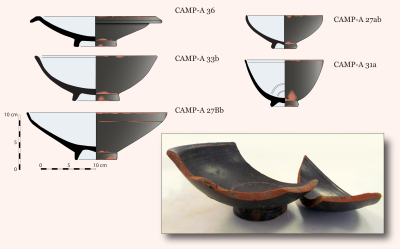
During the Iron Age (750-125 BC), the Celtic-speaking peoples of Mediterranean Gaul were concentrated in densely settled, fortified sites often referred to as oppida (Garcia 2004; Py 2012). Also during this time period, these Celtic-speaking societies developed close commercial relationships with Etruscan traders, Massaliote Greek colonists and, later, merchants from the Italian peninsula (Dietler 2010a). As a consequence of these trading networks, in contrast to other areas of the Celtic-speaking world, in pre-Roman Mediterranean Gaul the ceramic vessels primarily used for eating and drinking were already imported, rather than being locally made. In this case, the dining assemblages of late Iron Age Mediterranean Gaul, from approximately 200-125 BC, consisted of black gloss fineware vessels imported from Italy, most prominently Campanian A black gloss fineware from the Bay of Naples, as defined by Lamboglia (1952), and later Morel (1981) (Figure 2).
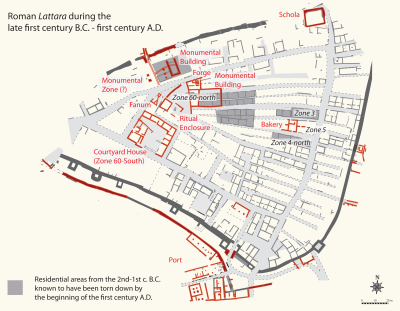
In a series of campaigns between 125-121 BC, the Roman Republic subjugated the peoples of Mediterranean Gaul, incorporating the region into a new province dubbed Gallia Transalpina, whose capital was the Roman colony of Narbo Martius (modern Narbonne), which was founded in 118 BC. During the first century BC, a not insignificant number of Italic colonists probably settled in the province (Mauné 2000), with Julius Caesar founding a second colony at Narbo Martius as well as a colony at Arelate (modern Arles). Around c. 25 BC, there was a general reorganisation of the conquered province, designated Gallia Narbonensis by Caesar Augustus in 22 BC, as well as an increasing monetisation of the local economy and an intensification of economic production. In particular, there was a dramatic increase in rural villas throughout the province in the first century BC, producing most notably wine for export throughout the western empire and transported in new Gallic amphorae (Boissinot 2001; Buffat and Pellecuer 2001). At the same time, notable changes apparently occurred in dining practices as well (Luley 2014). Specifically, by c. 25 BC black gloss fineware was no longer in production, and was being replaced by red gloss vessels, first made in workshops at Arezzo, Italy. Although it is somewhat unclear whether terra sigillata immediately replaced the earlier black gloss vessels, or whether there was a period in which the two were used contemporaneously, by the first century AD, Gallic terra sigillata was by and large the most important fineware in Gallia Narbonensis. Interestingly, although Gallic terra sigillata was produced in unprecedented quantities during the first century AD, at the sites discussed here the quantity of terra sigillata deposited into the archaeological record nevertheless seems to have been less than that for the earlier black gloss vessels (see below).
| Archaeological zone | Dates | Number of identifiable Gallic terra sigillata vessels | Data source |
|---|---|---|---|
| Lattara - Zone 3 | A.D. 25-100 | 28 | Py 1990a |
| Lattara - Zone 4 north | A.D. 1-50 | 31 | Py 1990b |
| Lattara - Zone 5 | A.D. 1-100 | 207 | Fiches 1994 |
| Lattara - Zone 60 north | A.D. 1-75 | 199 | Syslat |
| Ambrussum - Sector 4 | A.D. 40-100 | 102 | Fiches 1986 |
| Ambrussum - Sector 9 | A.D. 25-100 | 330 | Barberan 2009 |
| Carsalade (Nîmes) | A.D. 20-30 | 37 | Barberan 2013 |
| Maison au Grand Triclinium (Narbonne) | 2nd century A.D. | 106 | Sanchez and Sabrié 2011 |
The analysis here focuses on ceramic data from eastern Languedoc, specifically from the Gallic settlements of Lattara (modern Lattes), Ambrussum, and the rural site of Carsalade just outside Nîmes, as well as the important Roman colony of Narbo Martius (modern Narbonne) in western Languedoc (Figure 1, Table 1). For the site of Lattara, the ceramic data used in this article come from four different areas of the site (Zones 3, 4-north, 5, and 60-north) (Figure 3). The first two zones were possibly still residential areas of the settlement in the first century AD, although unfortunately no architectural remains can be associated with the deposits. Zone 60-north was a more public area, with an open-air sanctuary and small fanum (Py 2009, 163-65). For the site of Ambrussum, two different houses are represented: a courtyard house from Sector 9 of the site, located near the Via Domitia below the Iron Age occupation of the site (Fiches 1986), and another courtyard house (House A of Sector 4) from the Gallic oppidum (Fiches 2009) (Figure 4). The site of Carsalade is interesting in that it represents one of the few assemblages from a rural context (Barberan 2013). Carsalade lies a little less than 3km to the south-west of the boundaries of the Roman-period city of Nemausus (Nîmes), and just 350m to the south of the Via Domitia. Although not entirely excavated, the site consisted of at least two buildings, and based upon the remains of a stone press, a basin, and dolia, was a small to medium-sized farm dedicated to the production of wine. At Narbo Martius, ceramic data are available from the area of the city today known as the Clos de La Lombarde for the first century AD, especially from the occupation layers of several streets, as well as the late second-century occupation of a large house known as the Maison au Grand Triclinium (Sanchez and Sabrié 2011). The designations for specific types of vessels referenced in this article are based upon the standard series of typologies for Mediterranean France established by Michel Py (1993) in the corpus DICOCER (Dictionnaire des Céramiques Antiques en Méditerranée Nord-Occidentale).
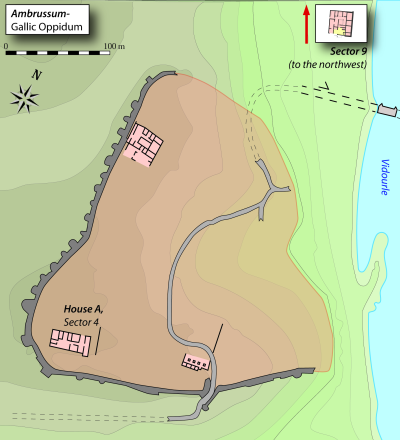
All the terra sigillata ceramics were found with other ceramics, such as 'communal' ceramics (as commonly categorised by archaeologists working in southern France) and amphorae, as part of the accumulation of general debris and trash that was largely deposited over long periods of time, often several generations. None of the assemblages can be identified as coming from specific dining events or actual table settings. Instead, the terra sigillata vessels identified were often probably thrown out over a period of time, along with a large number of other ceramics. On a general level, it is perhaps useful to note that there is often little explicit critical discussion in archaeological reports of the specific nature of deposits and how artefacts actually ended up in those deposits. More direct discussions of these issues are arguably needed when attempting to understand the social meaning of objects such as ceramics that were ultimately thrown away. In the case of Lattara, no architectural remains can be associated with the different areas of the site, but the ceramics seem to come from the steady accumulation of trash and debris over the course of several generations in the first century AD. In the case of Sector 9 from Ambrussum, the terra sigillata sherds, along with a larger number of other ceramics, were found in alternating layers of rubble and occupation levels within the walls of the house, corresponding to six distinct phases in the occupation of the house, in which parts of the mudbrick walls were torn down and rebuilt (Fiches 2009). Likewise, the ceramics from House A of Sector 4 of Ambrussum appear to be part of the rubble and accumulated debris deposited with the abandonment of the house c. AD 100 (Fiches 1986).
Regarding the site of Carsalade, the ceramic assemblage comes from the fill of a large pit to the south-east of one of the buildings, into which a considerable number of ceramic vessels were thrown, apparently all at once, and shortly after the hole was dug (Barberan 2013, 154). Based upon the ceramic types present, the fill of the pit containing the ceramics probably dates to c. AD 20-30 (Barberan 2013, 175), and given the nature of the fill, it is likely that the ceramics represent accumulated trash thrown out after the pit was dug, possibly to obtain earth for constructing mudbrick walls (Barberan 2013, 175). Lastly, the Maison au Grand Triclinium survives only in its last phase of occupation, dating to the end of the second century AD and beginning of the third century AD (Sabrié 2011). Here the excavations revealed a destruction layer of the house, dating to c. AD 230, containing the remains of ceramic vessels used during the last period of occupation of the house in the late second century AD (Sanchez and Sabrié 2011, 222).
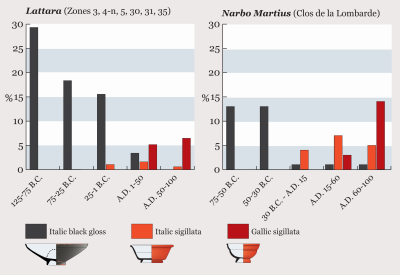
With the production of Gallic terra sigillata at sites like La Graufesenque at the very end of the first century BC and the beginning of the first century AD, the only major fineware in use in the dining assemblages was Gallic terra sigillata. Interestingly, however, even after the production of Gallic terra sigillata, the total number of fragments of terra sigillata at sites in Mediterranean Gaul does not seem to have been as great as the previous total number of fragments of Italic black gloss, which at its height at Lattara c. 125-75 BC made up as much as 29 per cent of all ceramics (excluding amphorae and dolia) (Figure 5). Even when Gallic terra sigillata production was at its height in the second half of the first century AD, terra sigillata made up at most slightly less than 20 per cent of all ceramics, in this case at the site of Clos de la Lombarde in Narbonne (Figure 6). Furthermore, the under-representation of terra sigillata compared with earlier Italic black gloss fineware does not appear to be the result of a corresponding increase in the production of communal ceramics, which could theoretically decrease the overall percentage of terra sigillata even if the absolute number of vessels may have been equal to or greater than earlier Italic black gloss vessels. Specifically, when the amount of Italic black gloss sherds found in a known domestic context (in this case Zone 35 for the period 125-75 BC at Lattara) is compared with the number of terra sigillata sherds at a later domestic context occupied for approximately the same amount of time (in this case the house from Sector 9 at Ambrussum for the period AD 50-100), one finds that there was still a much higher number of Italic black gloss sherds per square metre of excavated domestic space than there were terra sigillata sherds (Figure 7). In fact, based upon both the total number of fragments and the minimum number of vessels, while the total sherds per square metre for all ceramics (excluding amphorae and dolia) at Zone 35 at Lattara and Sector 9 at Ambrussum were relatively comparable, there was nevertheless over double the amount of Italic black gloss at Zone 35 at Lattara for the period 125-75 BC than terra sigillata sherds at Sector 9 at Ambrussum for the period AD 50-100.
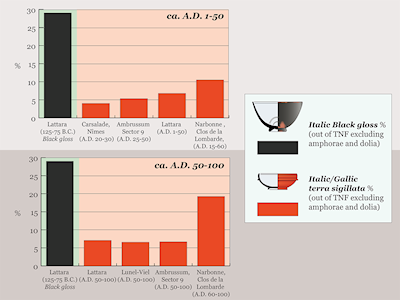

Overall then, Italic black gloss certainly appears to have been entering the archaeological record much more frequently than either Italic or Gallic terra sigillata, and a number of factors could explain this discrepancy. Firstly, and perhaps most importantly, the lower amounts of terra sigillata may be directly related to the widespread appearance of hand-blown glass vessels by the first century AD. Glass vessels, including plates, bowls, and cups for dining, are present at sites like Ambrussum (Conterio 2009) throughout the first century AD, although there are fewer glass than terra sigillata sherds, perhaps in part because the glass sherds, unlike the ceramic ones, could at least in theory have been melted down and reused, making any quantitative comparison difficult. It is also rather doubtful that the households represented here at Lattara or Ambrussum would have been wealthy enough to use metal (i.e. silver) tableware for dining. Additionally, the evidence from the House of the Menander from Pompeii suggests that bronze vessels were not widely used as tableware (cf. for types of bronze vessels: Allison 2006; see also Allison n.d.). Secondly, there is also the possibility that differing dining practices associated with Italic black gloss versus terra sigillata meant that the former was broken and discarded more readily. One can imagine a hypothetical scenario, for example, in which during the period before and immediately after the Roman conquest, Italic black gloss vessels were used for larger public feasts, in which vessels were thrown out (perhaps ceremoniously?) after the feast. By contrast, terra sigillata vessels were perhaps used more in the private home, and were thus broken less often. Lastly, in contrast to the relatively equal distribution of Italic black gloss fineware in large numbers of Gallic sites in the late second and first centuries BC (see for example Luley 2016), there appears to have been a much more unequal distribution of Gallic terra sigillata. During the second half of the first century AD in particular, the Roman colony of Narbo Martius (at least based upon the data from the area of the city today known as the Clos de la Lombarde) had a greater amount of terra sigillata than native and less urbanised sites in eastern Languedoc, such as Lattara, Ambrussum, or Lunel-Viel (Figure 6).
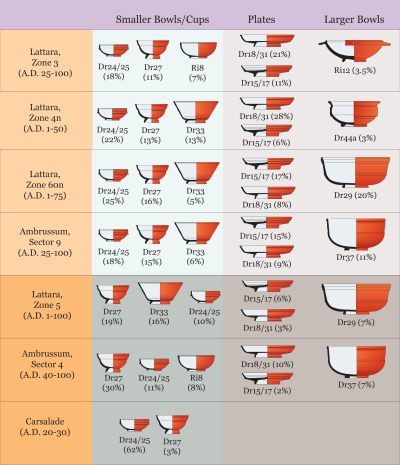
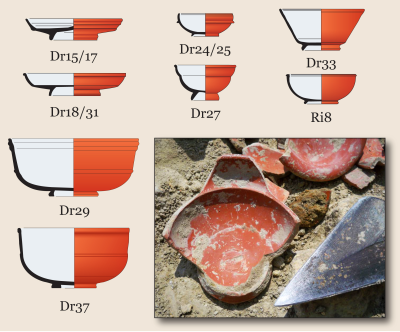
Perhaps unsurprisingly, the forms represented at the different sites appear to have been fairly limited, implying the mass production of a small number of highly standardised forms (Figure 8). Specifically, the most common types of plates were Drag. 15/17 and Drag. 18/31, large bowls Drag. 29 and Drag. 37, and cups and smaller bowls Drag. 24/25, Drag. 27, Drag. 33 and Ritterling 8 (Figure 9). It should be added here that for Carsalade, Barberan (2013, 156) states that 23 rims could be identified as either Haltern 12 (Conspectus 33.1) or an early form of Drag. 24/25. For the purposes of this article, these 23 rims are here counted as Drag. 24/25, since there were no other occurrences of Haltern 12/Conspectus 33.1 for the other archaeological contexts analysed, thereby avoiding the necessity of adding another category for the analysis of forms. Although there was a limited number of Gallic terra sigillata forms, there does not appear to have been one standard set for these different forms, based upon the relative importance or unimportance of different types of vessels between different sites, as well as within the same site. An examination of different contexts from the Gallic sites of Lattara, Ambrussum, and Carsalade reveals three broad groups of Gallic terra sigillata assemblages as preserved in the archaeological record: Group 1 in which plates made up between 40-60 per cent of all dining vessels (Zones 3 and 4-north from the site of Lattara); Group 2 in which there was a relatively equal distribution of plates and larger bowls, with both making up between 20 and 30 per cent of all dining vessels (Zone 60-north from Lattara and the courtyard house from Sector 9 of Ambrussum); and finally Group 3 in which bowls and cups made up over 60 per cent of all dining assemblages (the courtyard house from Sector 4 of Ambrussum, Zone 5 from Lattara, and the site of Carsalade) (Figures 10 and 11). With regard to the differences in the specific types of cups and bowls for the three groups, it is important to note that for Groups 1 and 2, the generally smaller Drag. 24/25 cups were more common than the somewhat larger Drag. 27. Conversely, within Group 3, for Sector 4 from Ambrussum and Zone 5 from Lattara Drag. 27 cups were more common than Drag. 24/25.
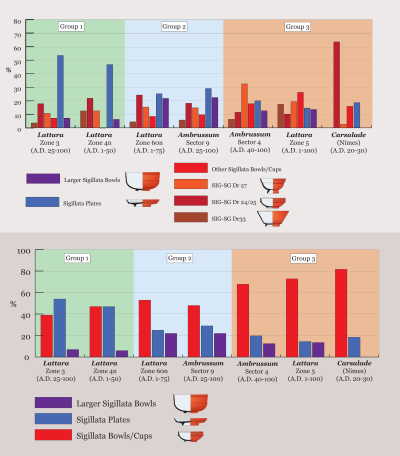
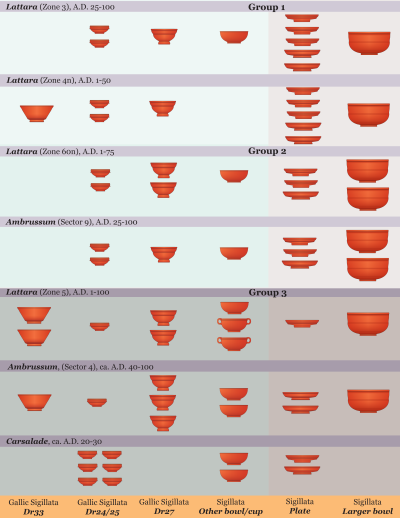
At the Roman colony of Narbo Martius, the second-century AD terra sigillata assemblage from the luxurious Maison au Grand Triclinium most resembled the assemblage from Sector 9 of Ambrussum, belonging to Group 2, with cups and bowls making up 43 per cent of the dining assemblages, plates 36 per cent, and larger bowls 25 per cent (Figure 12). Interestingly, Zone 5 of Lattara, which lies between Zones 3 and 4-north (Figure 3), has a very distinctive and different pattern of discard from the neighbouring two zones, where plates predominate, very likely reflecting real differential patterns of cultural practices. Furthermore, it is also striking to note the clear similarities between Zone 60-north of Lattara and Sector 9 of Ambrussum, both of which are represented by over 200 identifiable Gallic terra sigillata vessels each, representing two entirely different archaeological contexts. Overall then, the clear patterns present here cannot be attributed to simply an insufficient sample size, or to an inability to define distinct contexts.
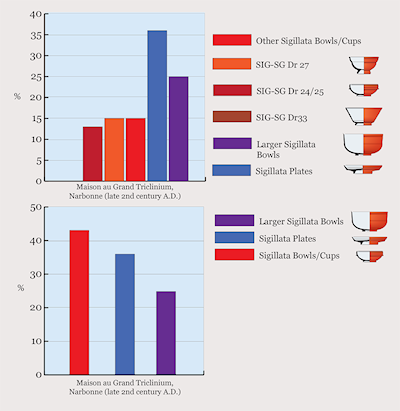
Although the different terra sigillata assemblages discussed here do not represent actual dining sets or individual dining events, such as meals or feasts, they do nevertheless suggest distinctive and consistently recurring practices. If all social action occurs within larger systems or webs of cultural symbols, and all social action is thus imbued with cultural meaning (see for example Geertz 1973, especially 5, 7, 12), then it follows that all material culture is likewise always and necessarily constructed with cultural meaning (see for example Hodder 1995, especially 12-13). Real human actors, working within systems of symbols, threw out certain terra sigillata vessels at certain times in their lives, and the patterns present in the archaeological record are a direct result of these culturally meaningful actions. Moving beyond the directly accessible patterns of deposition in the archaeological record, it follows that the same human actors made culturally informed choices about the terra sigillata vessels they purchased and then employed in daily life. The patterns of terra sigillata discard and deposition in the archaeological record is thus part of a larger system of meaning, and we can arguably use the proportions of different discarded vessels as found in the archaeological record to speculate indirectly about the proportions of terra sigillata vessels in use within a given time period.
In this sense, although the patterns identified here do not and cannot represent individual dining practices, they do arguably reflect the broader dispositions of human action, or habitus. The distinctive patterns of terra sigillata vessels visible in the archaeological record at the different sites represent the different structured actions of groups of people acting according to different learned dispositions. Although individuals at any given moment in time may have used terra sigillata vessels in ways that might not correspond to the relative proportions of vessel forms ultimately thrown out (Figure 11), these generalised proportions arguably represent the overall tendencies of individuals over the course of years and decades when using, and then ultimately throwing out, terra sigillata vessels. Furthermore, the material practices employing specific proportions of vessels, such as more bowls than plates, would in turn have structured the future tendencies or habitus of later generations. At Zones 3 and 4-north at Lattara, as well as to a slightly lesser extent Zone 60-north from Lattara and the house from Sector 9 at Ambrussum, there was a tendency for the occupants over time to use (or at least throw away) a greater proportion of terra sigillata plates. Conversely, at Zone 5 of Lattara, the house from Sector 4 at Ambrussum, and the rural farm at Carsalade, there was a tendency over the course of decades, and even generations, for social actors to employ a greater proportion of bowls and cups.
With regard to the function of the different vessels within the three different groups, it should be noted that it is perhaps ultimately futile to try and pinpoint an exact function for any of the terra sigillata types mentioned here, especially given the fact that none of the assemblages represent actual dining services. From one day to another many of the different types could have assumed different functions. With that in mind, and drawing upon previous research (e.g. Dannell 2006), some preliminary thoughts can, however, at least be attempted. Firstly, the form category with, arguably, the most limited function would have been the plates (Drag. 15/17 and Drag. 18/31), which tended to be fairly small in diameter and shallow with a flat bottom. Presumably, the function of these vessels would have largely been restricted to holding solid or relatively semi-solid food. The larger bowls (Drag. 29 and Drag. 37) often exceed 20cm in diameter, and one wonders whether there would be any practical value in regularly drinking from any vessel larger than 17 or 18cm in diameter. These larger bowls could thus have been used for serving any kind of solid, semi-solid, or liquid food, or, as Dannell (2006, 158) suggests, perhaps also for mixing and preparing wine or beer. By far the most versatile forms were the cups and smaller bowls (Drag. 24/25, Drag. 27, Drag. 33, Ritterling 8), which could have assumed various functions. Based upon graffiti from the workshops at La Graufesenque, Dannell (2006, 158-62) tentatively suggests that the Drag. 24/25 may have often been used as containers for holding dipping sauces, with Drag. 27 having multiple functions, including drinking, and Drag. 33 perhaps used for drinking wine and beer. Certainly the smallest Drag. 24/25 cups, which were often as small as 6-7cm in diameter, would have held perhaps too small a portion of drink to be of any practical use on a regular basis as a drinking vessel (Figure 13).
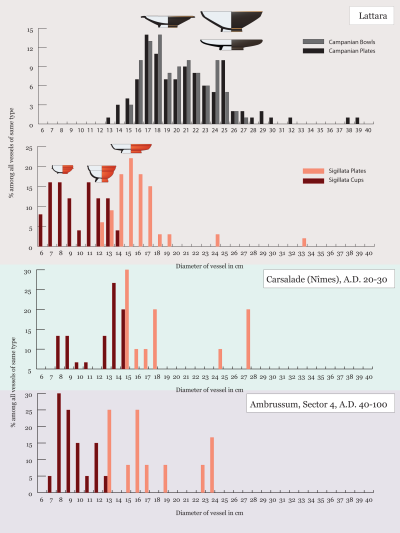
If, for the moment, we tentatively accept these speculations, then the vessels from Group 1, and arguably also Group 2, were probably more restricted in function. Here, the plates and predominance of smaller Drag. 24/25 cups may point toward more formal dining settings, with small, individual plates for diners and cups for holding sauces, likely complemented by small thin-walled drinking goblets. Furthermore, the relatively small size of all these vessels may have been associated with dining while reclining in a triclinium. By contrast, the predominance of smaller bowls and cups (Drag. 24/25, Drag. 27, Drag. 33, Ritterling 8) in Group 3 suggests a greater flexibility in the function of the various vessels, representing perhaps less formal dining practices. Furthermore, the importance of bowls less than 16-18cm in diameter within Group 3 seems to hearken back to the predominance in pre-Roman assemblages of Italic black gloss bowls (especially Campanian A 27ab or Campanian A 31b) that generally measured between 13-16cm in diameter (see Luley 2014, 761). In the case of the pre-Roman assemblages, before the appearance of thin-walled drinking goblets and possibly also the Grey Catalan one-handled 'goblets' toward the end of the second century BC, there appears to be no other vessel suited to drinking wine or beer apart from cups or small bowls (see for example Py 1990c, 349-71, 545-55, 566-75). Sometimes these vessels had two handles, as with the Greek style skyphoi or kylikes, although this was becoming less common by the end of the third century BC. Even in the first century BC, small black gloss bowls predominate over any other vessel suited for drinking, leading archaeologists to speculate that one of their functions (albeit not the only function) may have been as drinking bowls. Certainly, in the late second-century and early first-century BC tombs in eastern Languedoc containing amphorae, pitchers, and Italic black gloss vessels, small Italic black gloss bowls seem to be the only reasonable candidate for a drinking vessel (see for example Garmy et al. 1981; Py 1980; Py 1983).
Perhaps then Group 3, with a similar predominance of cups and small bowls, reflects more traditional dining practices hearkening back to earlier Iron Age assemblages. It is certainly interesting that the terra sigillata Drag. 33 has a similar size and morphology to the earlier Italic black gloss bowls such as Campanian A 27ab or Campanian A 31b (compare for example Figure 2 and Figure 9). Furthermore, the occupants of House A from Sector 4 of Ambrussum, located within the old Iron Age oppidum, as well as Carsalade, certainly may have been Gallic in origin, as opposed to Italic colonists. However, the presence of a large number of terra sigillata Drag. 24/25 cups from the seemingly modest farm of Carsalade requires explanation, especially given the suggestion that Drag. 24/25 cups were used for sauces. Would rural farmers of presumably relatively modest means have required a large number of sauce containers? In the case of Carsalade, the cups belonging to the type Drag. 24/25 (or Haltern 12/Conspectus 33.1) interestingly all tended to be relatively large, typically between 13-15cm in diameter (Barberan 2013), noticeably larger than in other contexts (Figure 13). Perhaps then the occupants of Carsalade simply favoured vessels that could serve multiple purposes (serving food, drinking, etc.), as opposed to the less versatile plate, illustrating the way in which a vessel type like a cup or small bowl could be used in different ways in different contexts.

What the actual social groups were as represented by these three different terra sigillata groups is unclear. Interestingly, there does not appear to be any obvious differences in dining assemblages specifically related to social class. For the archaeological contexts in which there are enough architectural remains present to reconstruct the size and quality of the house (specifically the Maison au Grand Triclinium from Narbo Martius and Sectors 4 and 9 from Ambrussum), there does not appear to be any significant differences in the dining assemblages based upon the size or quality of the house (Figure 14). Specifically, the very wealthy and opulent house known as the Maison au Grand Triclinium from the Clos de la Lombarde at the Roman colony of Narbo Martius has a very similar dining assemblage to the much more 'working class' house from Sector 9 at Ambrussum. The house from Narbo Martius was relatively large and decorated with marble floors in the central triclinium, whereas the smaller courtyard house from Sector 9, which was divided into living and artisanal sections, had dirt floors and austere, white-washed walls. It is possible of course that the slaves associated with the Maison au Grand Triclinium may have most often used the Gallic terra sigillata assemblages, with the pater familias and his fellow diners using glass or silver dining vessels, perhaps in part explaining the similarity in assemblages between the Maison au Grand Triclinium and Sector 9 at Ambrussum. At the same time, however, it is not unreasonable to suppose that at times all occupants of the Maison au Grand Triclinium, even the patriarch of the household, would have used terra sigillata vessels in informal, daily meals. By contrast, although Sector 4 from Ambrussum was likely inhabited by a family that was possibly somewhat wealthier than the family living in Sector 9, the dining assemblage from Sector 4 is quite different from either Sector 9 or the Maison au Grand Triclinium, being characterised rather by a predominance of bowls and cups.
Based upon the data presented from the different sites here, two important conclusions can be drawn concerning the adoption of terra sigillata dining assemblages and their use in the first century AD in Gallia Narbonensis. Firstly, it is quite apparent that the amount of terra sigillata deposited into the archaeological record for the late first century BC and first century AD is noticeably lower than the amount of Italic black gloss that was deposited in the second and first centuries BC. Secondly, it is apparent that dining assemblages, as best they can be imperfectly reconstructed based upon the trash thrown away over time, differed, with some being more conservative and traditional in nature than others. This diversity in dining assemblages is strikingly absent from the dining assemblages of Italic black gloss for the second and first centuries BC in eastern Languedoc, when there was a much more similar array of dining assemblages within and between native Gallic sites (Luley 2014). In contrast, for the first century AD there is a noticeable distinction between dining assemblages in which bowls and cups predominated and those in which plates and larger bowls were predominant. In the case of the former, these assemblages (such as those at Carsalade, Sector 4 of Ambrussum, and Zone 5 from Lattara) may represent more traditional dining practices, in which multi-functional smaller bowls and cups could serve a variety of tasks. Other assemblages (such as those from the Maison au Grand Triclinium at Narbo Martius, Sector 9 at Ambrussum, or Zones 3, 4-north, and 60 from Lattara) may have been associated with more formal dining. This is not to say that one group of dining assemblages necessarily represents native Gauls and another group Italian settlers, but rather that the different assemblages possibly represent the presence of distinct culturally structured dispositions of dining that potentially varied from one cultural or ethnic tradition to another. At the same time, although the data discussed here are suggestive of the way in which diverse social groups may have used terra sigillata in divergent ways according to varying cultural logics, this study is nevertheless ultimately incomplete. In particular, more work is needed to identify instances of specific dining events and table sets, especially in regard to offerings in tombs (which likely represented practices entirely divergent from daily consumption) or dining assemblages that may have been immediately thrown out after a given meal. In this way, individual actions can be juxtaposed with broader and long-term tendencies of various communities, providing a fuller understanding of the range of experiences of social groups living under Roman rule.
Internet Archaeology is an open access journal based in the Department of Archaeology, University of York. Except where otherwise noted, content from this work may be used under the terms of the Creative Commons Attribution 3.0 (CC BY) Unported licence, which permits unrestricted use, distribution, and reproduction in any medium, provided that attribution to the author(s), the title of the work, the Internet Archaeology journal and the relevant URL/DOI are given.
Terms and Conditions | Legal Statements | Privacy Policy | Cookies Policy | Citing Internet Archaeology
Internet Archaeology content is preserved for the long term with the Archaeology Data Service. Help sustain and support open access publication by donating to our Open Access Archaeology Fund.